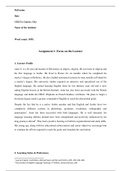Full name
Date
CELTA Course, City
Name of the institute
Word count: 1095.
Assignment 1: Focus on the Learner
1. Learner Profile
Amir S. is a 26 year old teacher of Electronics in Algiers, Algeria. He was born in Algeria and
his first language is Arabic. He lived in France for six months where he completed his
master’s degree in Robotics. He also studied automated systems for nine months in Poland for
a master’s degree. His university studies required an intensive and specialised use of the
English language. He started learning English when he was thirteen years old and is now
taking English lessons at the British Institute. Amir has also been successful with the French
language and holds the DELF (Diploma in French Studies) certificate. He plans to begin a
doctorate degree needs a greater command of English to reach his educational goals.
Despite the fact that he is a native Arabic speaker and that English and Arabic have two
completely different systems in phonology, grammar, vocabulary, orthography and
punctuation1, Amir has been successful with both languages. He is well educated: his
language learning abilities attitude have been strengthened and positively influenced by his
long journeys abroad2. They had a positive bearing on both his organizational and study skills.
His young age, along with his educational achievements and career objectives encourage him
to continue his efforts required to reach his goals and stimulate his motivation.
2. Learning Styles & Preferences
1
Learner English, 2nd Edition, Michael Swan and Bernard Smith, p195, 199, 200, 208.
2
The practice of English Language Teaching, 5th Edition, Jeremy Harmer, p91
, Amir’s natural learning styles are undoubtedly Visual and the Kinaesthetic ones. Not only
was it confirmed by two tests that I made him take (VARK & Multiple Intelligences), but I
also came to this conclusion when I observed him closely during the lessons. His positive
reactions to illustrations of new vocabulary, group work, jigsaw listening, gesturing activities
given by the teacher and the fact that he is a skilled athlete3 corroborate my assumptions.
He is also an extroverted person. He “wants interaction with external people”4 and he does not
lose one opportunity to speak English and share with others.
As a Kinaesthetic and Visual learner, Amir is more attracted to activities involving his body –
like the snowball fight as a getting-to-know-you ice breaker which he enjoyed, and moving
around during follow-up activities – and his thoughts and feelings through visualisation5. It
deeply affects his learning since he will show much more commitment with activities
comprised of pictures, flashcards, colours and/or or body language. Other activities involving
individual or grammar-centred work may not arouse the same interest in him and will result in
a lack or loss of motivation.
3. Linguistic Ability
3.1.
Speaking & Writing
Our learner is able to take part in unpredictable exchanges 6, for example, casual conversations
as he showed me several times at the British Institute. He is confident and is not afraid of
making mistakes. He can achieve his communicative goals with the appropriate language and
the right register (e.g. invitations). He can speak fluently and converse freely.
Amir has effective writing skills. He has “a command of a range of styles and [is] able to
adopt an appropriate tone”7. Moreover, his written discourse is efficiently organised. His
writings during the classroom and outside (e.g. emails) show both coherence and cohesion. 8
Reading & Listening
3
Gardner’s framework of multiple intelligences (1983) identityandtype.wordpress.com
4
Language Learning styles and strategies: An overview, Rebecca L. Oxford, PhD, p4
Hyperlink was valid on the 16/05/16 http://web.ntpu.edu.tw/~language/workshop/read2.pdf
5
From the table adapted from Jeremy Harmer's book The Practice of English Language Teaching which was
originally taken from 'How to use Gardner's intelligences in a class program' by M Loon for the University of
Canberra.
6
Learning to Teach English, A practical introduction for new teachers, Peter Watkins, p78
7
Learning to Teach English, A practical introduction for new teachers, Peter Watkins, p71
8
The practice of English Language Teaching, 5th Edition, Jeremy Harmer, p18




